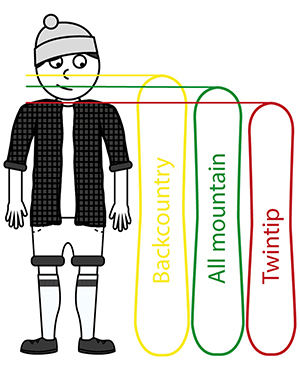Purchasing Snowboards
Your choice of snowboard is significantly influenced by your skill level and your enthusiasm for riding on the piste, in the park, or off-piste. Additional crucial elements include your foot size, weight, and height.
How to Determine the Length and Width of Your Snowboard
- Snowboard Length should align with your terrain preference and height. Typically, your board ought to reach between your shoulder and the mid-point of your head. Usually, longer boards are ideal for backcountry/off-piste areas, while shorter ones are best for freestyle activities. A medium-length board is adaptable, fitting for all mountain environments.
For novices and children, it's usually advised to select a slightly shorter board for ease and enjoyment. Size guides, if available, are provided on individual snowboard product pages.
Nowadays, brands offer model-specific size charts based on weight, which is likely the most accurate way to select the correct snowboard length. - Snowboard Width is primarily divided into Standard and Wide. Wide boards are suitable for shoe sizes 44 and above. This does not apply to junior wide boards.

The Three Categories of Snowboards
- Twintip boards excel in park tricks, but are equally enjoyable on the piste. Both ends of the snowboard are completely identical, with centrally positioned bindings, allowing easy riding in both directions and trick landing.
- All Mountain snowboards offer the utmost versatility. They resemble the shape of a twintip snowboard but have bindings, flex, and a balance point shifted backwards. Ideal for a wide range of uses, these boards are well-suited for the piste, park, and off-piste.
- Backcountry: Specifically crafted for deep powder off-piste, this snowboard shape closely mirrors a surfboard. Its large surface area provides exceptional flow in deep snow.
Snowboard Shapes and Styles
Shape
- Directional: Designed for riding in a single direction, commonly on the piste or off-piste. It features a stiffer tail, offering high-speed stability.
- Twin: With a symmetrical front and back, this shape is ideal for park use and tricks. Twin-shaped boards can be ridden in either direction.
- Directional Twin: Combines characteristics of both shapes, commonly designed for all-mountain and freestyle use.
Baseline Design
The baseline (the bottom of a snowboard) can be camber, rocker, or flat. These configurations may be mixed, depending on the snowboard's intended use.

- Rocker: Characterised by a board curving upwards at the tip and/or tail, which is advantageous for powder conditions and easy turns. It offers less resistance, making it a strong choice for park use.
- Camber: Involves the nose and tail being pressed down into the snow, expanding the snow contact area and enhancing edge grip.
- Flat: Ensures full contact with the snow surface, providing greater stability than a traditional rocker and facilitating easy turns.
